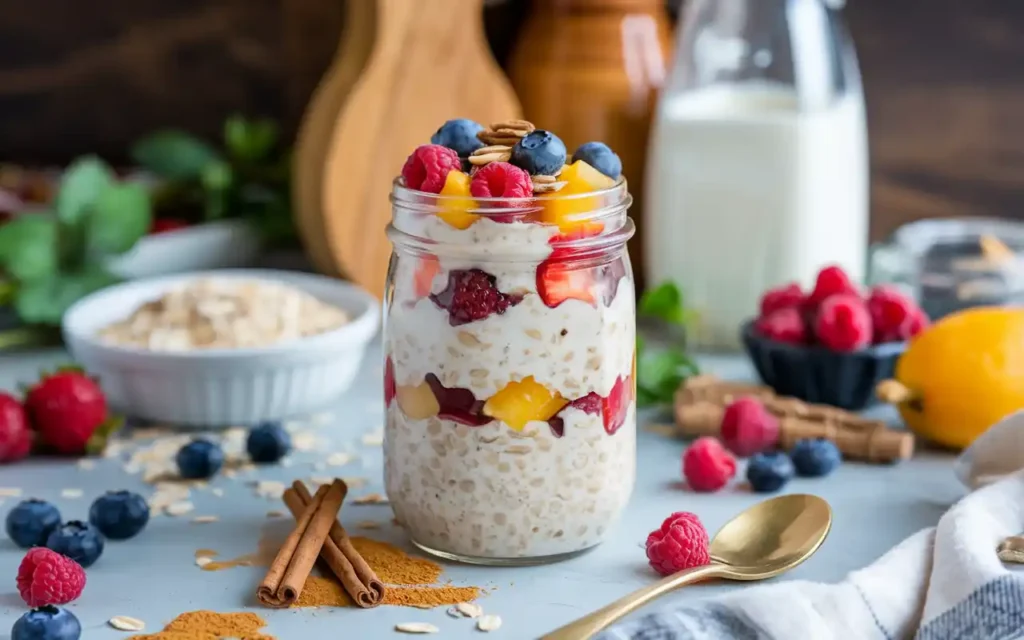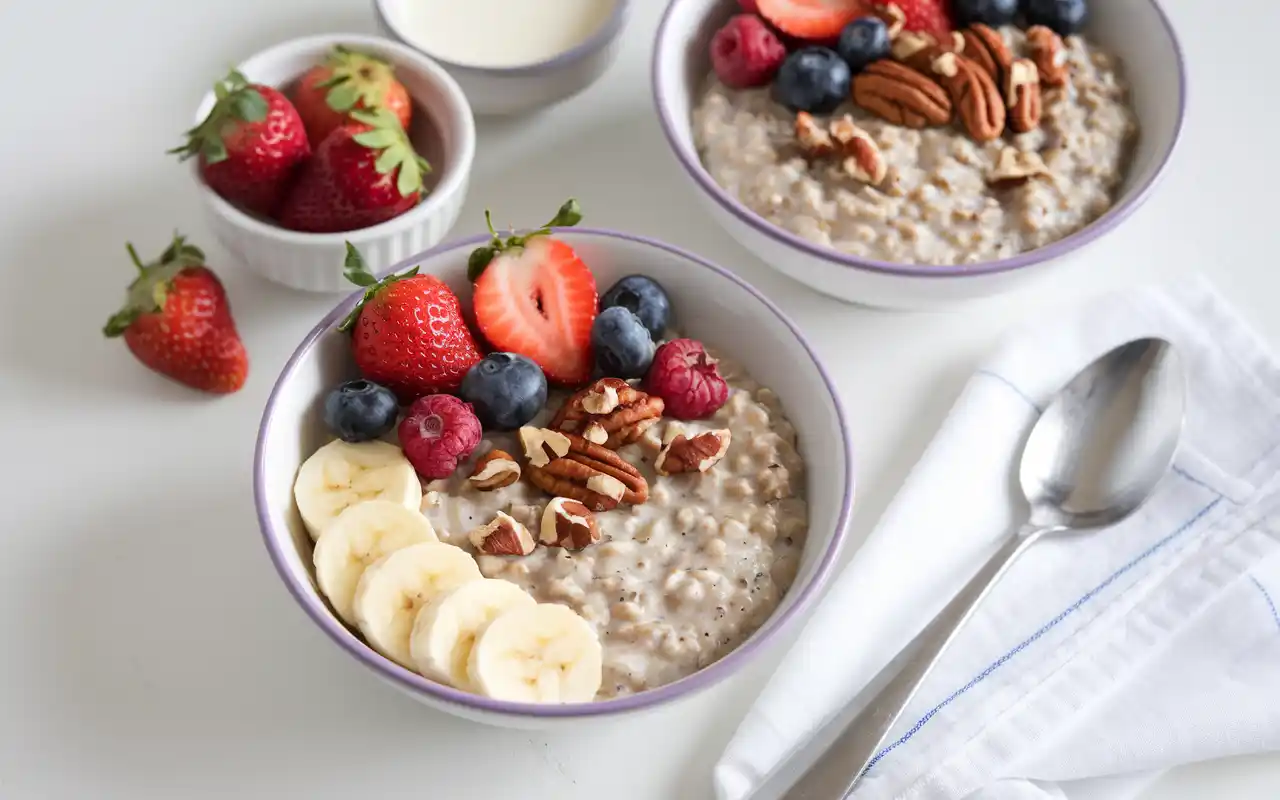In recent years, overnight oats have revolutionized the way we approach breakfast preparation. This versatile, nutrient-rich dish has gained popularity among health-conscious individuals seeking convenient yet wholesome morning meals. The beauty of overnight oats lies in their simplicity and adaptability, particularly when prepared without yogurt, opening up new possibilities for dietary preferences and creative culinary expressions.
What Are Overnight Oats?
Definition and Popularity
Overnight oats represent a modern interpretation of traditional oatmeal, where raw oats are soaked in liquid for several hours or overnight, resulting in a creamy, ready-to-eat breakfast. This preparation method has gained widespread acceptance due to its convenience and alignment with current lifestyle trends emphasizing healthy, time-efficient meal solutions.
Why Make Them Without Yogurt?
The evolution of overnight oats has led to numerous variations, with yogurt-free versions emerging as a popular alternative. This adaptation caters to diverse dietary needs while maintaining the dish’s fundamental appeal and nutritional benefits.
Why Make Overnight Oats Without Yogurt?
Dietary Considerations
Many individuals face dietary restrictions that make traditional yogurt-based overnight oats unsuitable. Lactose intolerance affects a significant portion of the global population, while the growing vegan movement has increased demand for dairy-free alternatives. Creating overnight oats without yogurt ensures these nutritious breakfast options remain accessible to everyone.
Taste and Texture
The absence of yogurt allows for more precise control over the final consistency and flavor profile. Without yogurt’s characteristic tanginess, other ingredients can take center stage, resulting in a more customizable breakfast experience. The texture becomes smoother and more uniform, appealing to those who prefer a less acidic taste.
Adaptability
Yogurt-free overnight oats offer enhanced versatility in recipe creation. Alternative ingredients can be incorporated more freely, allowing for creative flavor combinations that might otherwise be overshadowed by yogurt’s dominant characteristics.
Ingredients for Overnight Oats Without Yogurt
Essential Base Ingredients
The foundation of yogurt-free overnight oats relies on high-quality rolled oats, carefully selected liquid bases, and thoughtfully chosen sweeteners. These core components establish the framework for endless variation possibilities. The ratio typically follows one part oats to two parts liquid, adjustable based on desired consistency.
Alternative Liquid Bases
Plant-based milk alternatives serve as excellent substitutes for both dairy milk and yogurt. Almond milk offers a light, nutty profile, while oat milk provides additional creaminess. Coconut milk imparts rich tropical notes, and various fruit juices can introduce natural sweetness and vibrant flavors.
Flavor Boosters and Add-ins
A diverse array of ingredients enhances both nutritional value and taste appeal. Fresh or dried fruits provide natural sweetness, while nuts and seeds contribute essential healthy fats and protein. Spices such as cinnamon, nutmeg, and vanilla extract introduce aromatic complexity.

Step-by-Step Guide to Making Overnight Oats
Preparation
Successful preparation begins with selecting appropriate containers. Mason jars or airtight containers with secure lids work exceptionally well, allowing for both proper refrigeration and convenient portability. The layering technique proves crucial for optimal results. Begin with the oats as the foundation, followed by your chosen liquid base. Additional ingredients should be strategically placed to maintain their integrity during the soaking process.
Storage Tips
Proper storage significantly influences the final quality of overnight oats. The ideal refrigeration period ranges from 6 to 12 hours, though some variations may benefit from extended soaking. For optimal freshness, consume within 48 hours of preparation. If incorporating fresh fruits or delicate toppings, consider adding these just before serving to maintain their texture and prevent oxidation.
Serving Suggestions
Presentation elevates the overnight oats experience from mere sustenance to an aesthetically pleasing meal. Consider layering ingredients in clear containers to showcase vibrant colors and textures. Fresh toppings, such as sliced almonds, fresh berries, or a drizzle of honey, can be artfully arranged just before serving. Temperature preferences vary; while traditionally served cold, gentle warming can enhance certain flavor combinations.
Variations of Overnight Oats Without Yogurt
Fruity Variations
Fruit-based variations offer endless possibilities for creative and nutritious combinations. A classic berry medley combines strawberries, blueberries, and raspberries for antioxidant-rich flavor. Tropical versions featuring mango, pineapple, and coconut transport taste buds to exotic destinations. Banana-based recipes provide natural sweetness and creamy texture, particularly when paired with nut butters or cacao.
Nutty and Chocolaty Options
For those seeking indulgent yet nutritious options, combinations of nuts and chocolate create satisfying alternatives. Dark cocoa powder introduces rich flavor while maintaining nutritional benefits. Nut butters, whether peanut, almond, or cashew, contribute protein and healthy fats while creating creamy consistency. Consider combinations like dark chocolate-almond or peanut butter-banana for guaranteed satisfaction.
Savory Oats
Breaking traditional boundaries, savory overnight oats offer intriguing alternatives to sweet versions. Incorporating ingredients like avocado, sun-dried tomatoes, and herbs creates unexpected yet delicious flavor profiles. These variations often benefit from additions like chia seeds or hemp hearts for protein enhancement, and can include spices like turmeric or black pepper for depth.
Seasonal Recipes
Adapting recipes to seasonal ingredients and flavors ensures year-round enjoyment. Autumn calls for pumpkin spice variations with real pumpkin puree and warming spices. Winter holidays inspire combinations of cranberry, orange, and warming spices. Spring welcomes fresh berry combinations, while summer embraces stone fruits and tropical flavors.
Common Mistakes to Avoid
Choosing the Wrong Ingredients
The type of oats significantly impacts the final result. Rolled oats prove optimal for overnight preparations, providing ideal texture and absorption properties. Steel-cut oats require longer soaking times and yield different textures, while instant oats often become too soft. Additionally, selecting appropriate liquid bases ensures proper consistency.
Incorrect Liquid Ratios
Achieving the perfect consistency requires attention to liquid-to-oat ratios. Too much liquid results in soupy texture, while insufficient liquid yields dry, dense results. The standard ratio of one part oats to two parts liquid serves as a starting point, adjustable based on personal preference and additional ingredients.
Over- or Under-Soaking
Timing plays a crucial role in achieving optimal texture. While overnight soaking typically produces ideal results, extended periods may lead to overly soft consistency. Conversely, insufficient soaking time prevents proper absorption and texture development. Monitor soaking duration and adjust according to preferred consistency and ingredient combinations.
This comprehensive guide provides the foundation for creating delicious, yogurt-free overnight oats while avoiding common pitfalls. Experimentation with various combinations and ratios will help develop personal preferences and signature recipes.
FAQs
What can you substitute for yogurt in overnight oats?
Several effective substitutes maintain the creamy texture traditionally provided by yogurt. Plant-based milk alternatives, particularly those with higher fat content like coconut or cashew milk, offer excellent results. Mashed bananas provide natural sweetness and thickness, while chia seeds create a gel-like consistency when soaked. Additionally, silken tofu blends seamlessly into the mixture, contributing protein without altering the flavor profile significantly.
Why is there yogurt in overnight oats?
Traditional overnight oats recipes incorporate yogurt primarily for its protein content and ability to create a creamy consistency. Yogurt also introduces beneficial probiotics and contributes to the overall nutritional profile. However, modern adaptations demonstrate that these benefits can be achieved through various alternative ingredients while accommodating diverse dietary preferences.
Are overnight oats healthy for weight loss?
Overnight oats can support weight management goals when prepared thoughtfully. The high fiber content promotes satiety, while complex carbohydrates provide sustained energy release. Without yogurt, careful attention to protein sources becomes essential. Incorporating ingredients such as protein-rich plant milk, chia seeds, or nut butters helps create a balanced meal that supports weight management objectives while maintaining nutritional adequacy.
What not to add in overnight oats?
Several ingredients can compromise the quality of overnight oats. Avoid adding highly acidic fruits directly to the mixture as they can break down the oats’ structure. Granola or crispy toppings should not be added during the soaking process as they become soggy. Additionally, certain spices may become bitter with prolonged soaking, and some artificial sweeteners might alter their taste profile over time.
Wrapping Up Your Overnight Oats Journey
The versatility and convenience of yogurt-free overnight oats make them an excellent addition to any breakfast repertoire. This preparation method accommodates various dietary preferences while offering endless opportunities for creative experimentation. The key to success lies in understanding the fundamental principles of preparation while maintaining the confidence to explore new flavor combinations and ingredients.
As you embark on your overnight oats journey, remember that perfection often comes through experimentation. Begin with the basic ratios and techniques provided, then gradually introduce variations that align with your taste preferences and nutritional goals. The beauty of this breakfast option lies in its adaptability and the opportunity to create personalized combinations that enhance your morning routine.
Whether pursuing health objectives, managing dietary restrictions, or simply seeking convenient breakfast solutions, yogurt-free overnight oats offer a reliable and satisfying option. Your journey with this versatile dish is limited only by your creativity and willingness to explore new possibilities.
